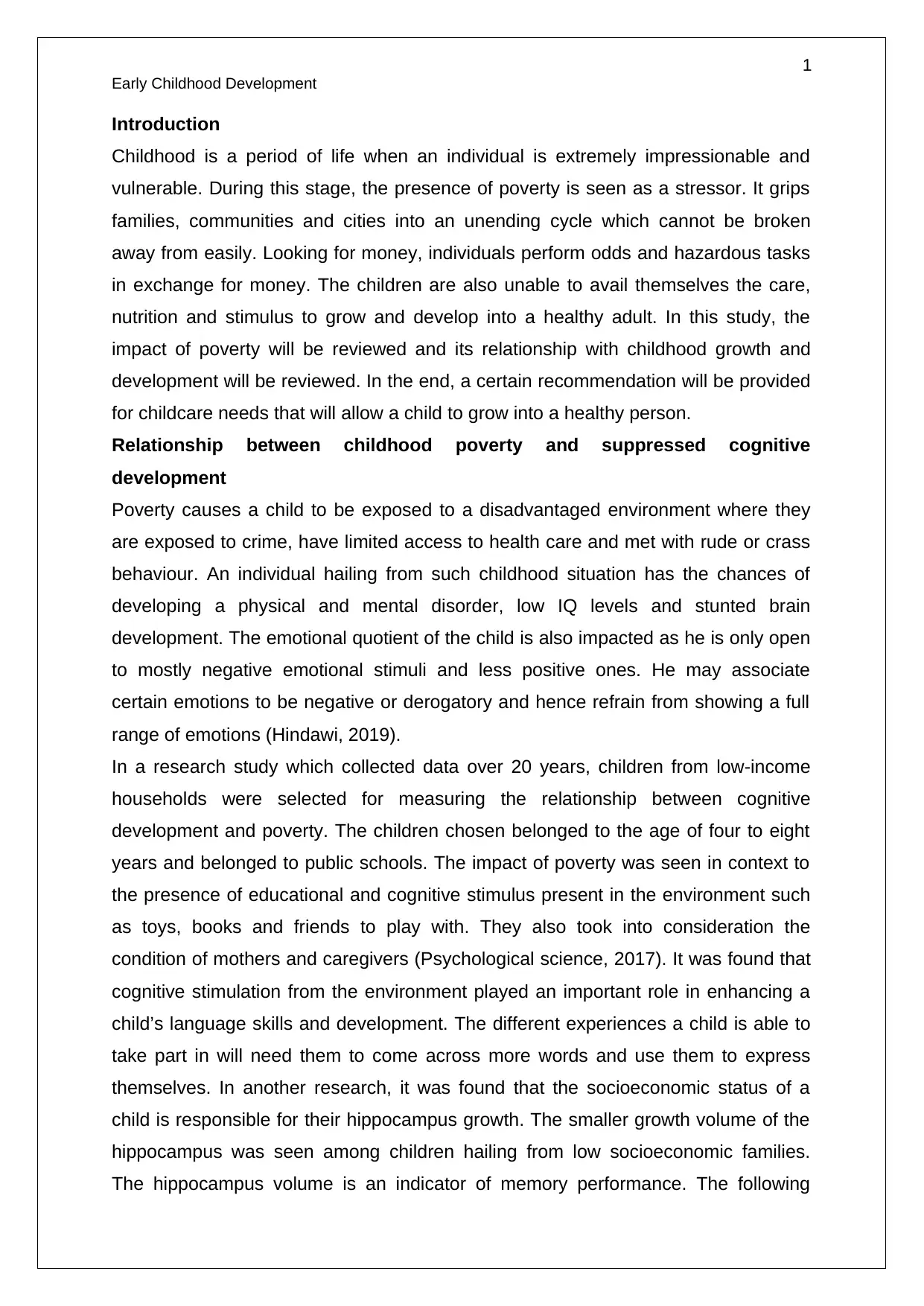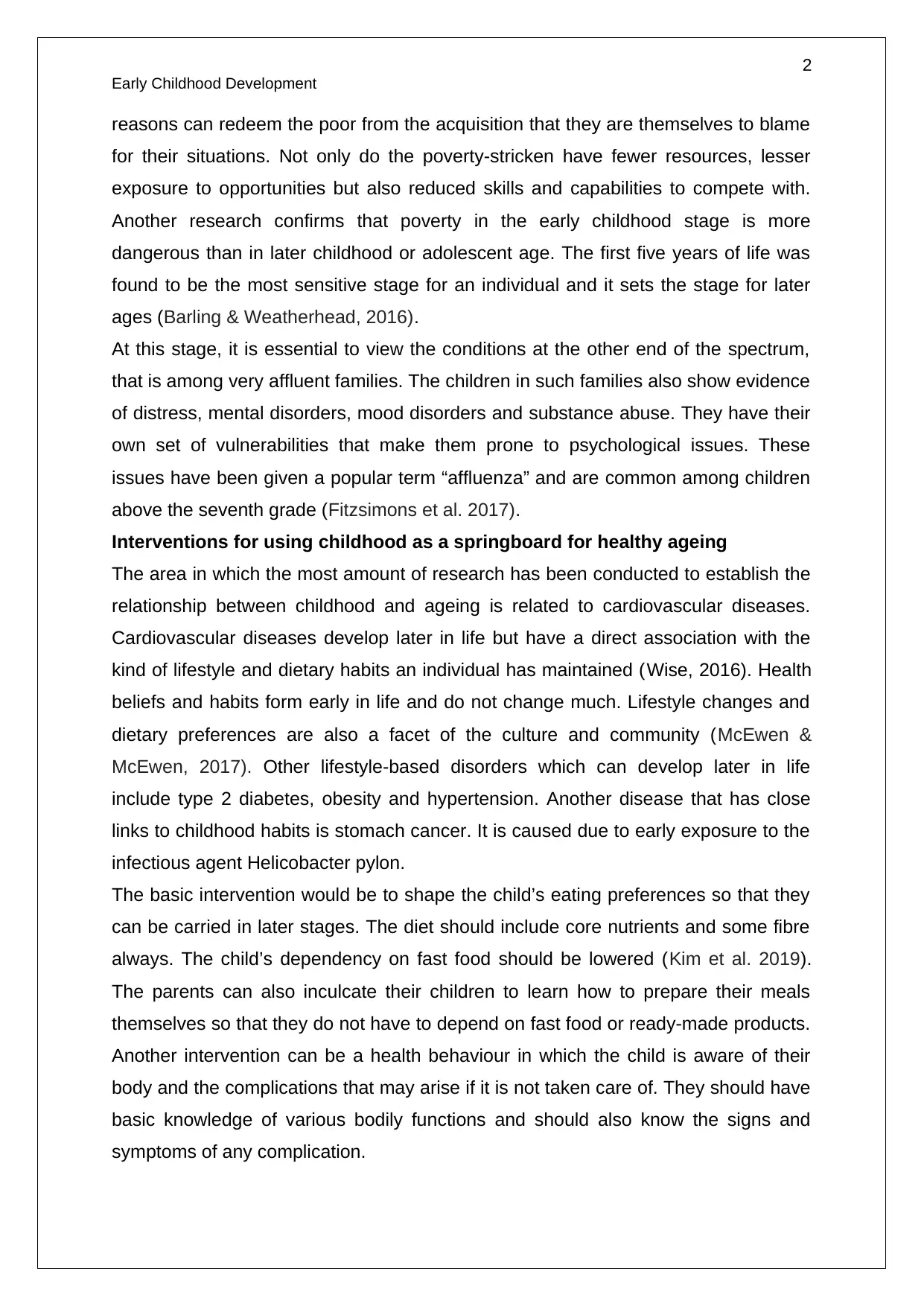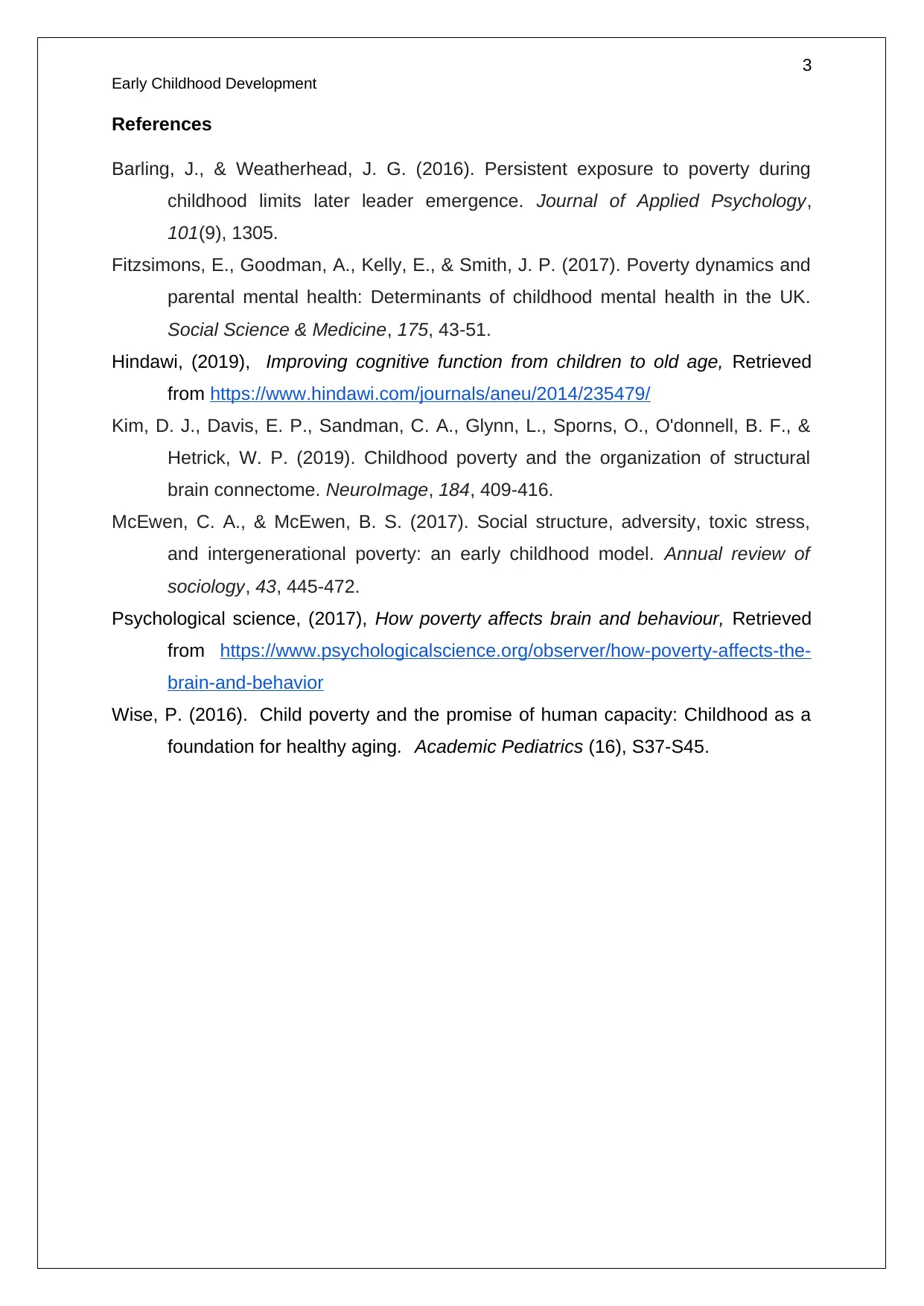Childhood Poverty, Cognitive Development, and Healthy Aging: A Report
VerifiedAdded on 2023/01/05
|3
|1161
|86
Report
AI Summary
This report examines the profound impact of childhood poverty on cognitive development, executive functioning, and overall health outcomes, with a focus on its long-term implications for healthy aging. The study highlights the detrimental effects of poverty, including exposure to disadvantaged environments, limited access to healthcare, and the potential for suppressed cognitive abilities and emotional development. It presents research findings that demonstrate the link between poverty and reduced cognitive stimulation, smaller hippocampus volume, and increased vulnerability to mental disorders. The report also discusses interventions, such as shaping children's eating habits, promoting health behavior awareness, and providing cognitive stimulation to mitigate the negative effects of poverty and promote healthy aging. These interventions aim to equip children with the necessary tools and resources to overcome the challenges associated with poverty and foster their development into healthy adults.

1
Early Childhood Development
Introduction
Childhood is a period of life when an individual is extremely impressionable and
vulnerable. During this stage, the presence of poverty is seen as a stressor. It grips
families, communities and cities into an unending cycle which cannot be broken
away from easily. Looking for money, individuals perform odds and hazardous tasks
in exchange for money. The children are also unable to avail themselves the care,
nutrition and stimulus to grow and develop into a healthy adult. In this study, the
impact of poverty will be reviewed and its relationship with childhood growth and
development will be reviewed. In the end, a certain recommendation will be provided
for childcare needs that will allow a child to grow into a healthy person.
Relationship between childhood poverty and suppressed cognitive
development
Poverty causes a child to be exposed to a disadvantaged environment where they
are exposed to crime, have limited access to health care and met with rude or crass
behaviour. An individual hailing from such childhood situation has the chances of
developing a physical and mental disorder, low IQ levels and stunted brain
development. The emotional quotient of the child is also impacted as he is only open
to mostly negative emotional stimuli and less positive ones. He may associate
certain emotions to be negative or derogatory and hence refrain from showing a full
range of emotions (Hindawi, 2019).
In a research study which collected data over 20 years, children from low-income
households were selected for measuring the relationship between cognitive
development and poverty. The children chosen belonged to the age of four to eight
years and belonged to public schools. The impact of poverty was seen in context to
the presence of educational and cognitive stimulus present in the environment such
as toys, books and friends to play with. They also took into consideration the
condition of mothers and caregivers (Psychological science, 2017). It was found that
cognitive stimulation from the environment played an important role in enhancing a
child’s language skills and development. The different experiences a child is able to
take part in will need them to come across more words and use them to express
themselves. In another research, it was found that the socioeconomic status of a
child is responsible for their hippocampus growth. The smaller growth volume of the
hippocampus was seen among children hailing from low socioeconomic families.
The hippocampus volume is an indicator of memory performance. The following
Early Childhood Development
Introduction
Childhood is a period of life when an individual is extremely impressionable and
vulnerable. During this stage, the presence of poverty is seen as a stressor. It grips
families, communities and cities into an unending cycle which cannot be broken
away from easily. Looking for money, individuals perform odds and hazardous tasks
in exchange for money. The children are also unable to avail themselves the care,
nutrition and stimulus to grow and develop into a healthy adult. In this study, the
impact of poverty will be reviewed and its relationship with childhood growth and
development will be reviewed. In the end, a certain recommendation will be provided
for childcare needs that will allow a child to grow into a healthy person.
Relationship between childhood poverty and suppressed cognitive
development
Poverty causes a child to be exposed to a disadvantaged environment where they
are exposed to crime, have limited access to health care and met with rude or crass
behaviour. An individual hailing from such childhood situation has the chances of
developing a physical and mental disorder, low IQ levels and stunted brain
development. The emotional quotient of the child is also impacted as he is only open
to mostly negative emotional stimuli and less positive ones. He may associate
certain emotions to be negative or derogatory and hence refrain from showing a full
range of emotions (Hindawi, 2019).
In a research study which collected data over 20 years, children from low-income
households were selected for measuring the relationship between cognitive
development and poverty. The children chosen belonged to the age of four to eight
years and belonged to public schools. The impact of poverty was seen in context to
the presence of educational and cognitive stimulus present in the environment such
as toys, books and friends to play with. They also took into consideration the
condition of mothers and caregivers (Psychological science, 2017). It was found that
cognitive stimulation from the environment played an important role in enhancing a
child’s language skills and development. The different experiences a child is able to
take part in will need them to come across more words and use them to express
themselves. In another research, it was found that the socioeconomic status of a
child is responsible for their hippocampus growth. The smaller growth volume of the
hippocampus was seen among children hailing from low socioeconomic families.
The hippocampus volume is an indicator of memory performance. The following
Paraphrase This Document
Need a fresh take? Get an instant paraphrase of this document with our AI Paraphraser

2
Early Childhood Development
reasons can redeem the poor from the acquisition that they are themselves to blame
for their situations. Not only do the poverty-stricken have fewer resources, lesser
exposure to opportunities but also reduced skills and capabilities to compete with.
Another research confirms that poverty in the early childhood stage is more
dangerous than in later childhood or adolescent age. The first five years of life was
found to be the most sensitive stage for an individual and it sets the stage for later
ages (Barling & Weatherhead, 2016).
At this stage, it is essential to view the conditions at the other end of the spectrum,
that is among very affluent families. The children in such families also show evidence
of distress, mental disorders, mood disorders and substance abuse. They have their
own set of vulnerabilities that make them prone to psychological issues. These
issues have been given a popular term “affluenza” and are common among children
above the seventh grade (Fitzsimons et al. 2017).
Interventions for using childhood as a springboard for healthy ageing
The area in which the most amount of research has been conducted to establish the
relationship between childhood and ageing is related to cardiovascular diseases.
Cardiovascular diseases develop later in life but have a direct association with the
kind of lifestyle and dietary habits an individual has maintained (Wise, 2016). Health
beliefs and habits form early in life and do not change much. Lifestyle changes and
dietary preferences are also a facet of the culture and community (McEwen &
McEwen, 2017). Other lifestyle-based disorders which can develop later in life
include type 2 diabetes, obesity and hypertension. Another disease that has close
links to childhood habits is stomach cancer. It is caused due to early exposure to the
infectious agent Helicobacter pylon.
The basic intervention would be to shape the child’s eating preferences so that they
can be carried in later stages. The diet should include core nutrients and some fibre
always. The child’s dependency on fast food should be lowered (Kim et al. 2019).
The parents can also inculcate their children to learn how to prepare their meals
themselves so that they do not have to depend on fast food or ready-made products.
Another intervention can be a health behaviour in which the child is aware of their
body and the complications that may arise if it is not taken care of. They should have
basic knowledge of various bodily functions and should also know the signs and
symptoms of any complication.
Early Childhood Development
reasons can redeem the poor from the acquisition that they are themselves to blame
for their situations. Not only do the poverty-stricken have fewer resources, lesser
exposure to opportunities but also reduced skills and capabilities to compete with.
Another research confirms that poverty in the early childhood stage is more
dangerous than in later childhood or adolescent age. The first five years of life was
found to be the most sensitive stage for an individual and it sets the stage for later
ages (Barling & Weatherhead, 2016).
At this stage, it is essential to view the conditions at the other end of the spectrum,
that is among very affluent families. The children in such families also show evidence
of distress, mental disorders, mood disorders and substance abuse. They have their
own set of vulnerabilities that make them prone to psychological issues. These
issues have been given a popular term “affluenza” and are common among children
above the seventh grade (Fitzsimons et al. 2017).
Interventions for using childhood as a springboard for healthy ageing
The area in which the most amount of research has been conducted to establish the
relationship between childhood and ageing is related to cardiovascular diseases.
Cardiovascular diseases develop later in life but have a direct association with the
kind of lifestyle and dietary habits an individual has maintained (Wise, 2016). Health
beliefs and habits form early in life and do not change much. Lifestyle changes and
dietary preferences are also a facet of the culture and community (McEwen &
McEwen, 2017). Other lifestyle-based disorders which can develop later in life
include type 2 diabetes, obesity and hypertension. Another disease that has close
links to childhood habits is stomach cancer. It is caused due to early exposure to the
infectious agent Helicobacter pylon.
The basic intervention would be to shape the child’s eating preferences so that they
can be carried in later stages. The diet should include core nutrients and some fibre
always. The child’s dependency on fast food should be lowered (Kim et al. 2019).
The parents can also inculcate their children to learn how to prepare their meals
themselves so that they do not have to depend on fast food or ready-made products.
Another intervention can be a health behaviour in which the child is aware of their
body and the complications that may arise if it is not taken care of. They should have
basic knowledge of various bodily functions and should also know the signs and
symptoms of any complication.

3
Early Childhood Development
References
Barling, J., & Weatherhead, J. G. (2016). Persistent exposure to poverty during
childhood limits later leader emergence. Journal of Applied Psychology,
101(9), 1305.
Fitzsimons, E., Goodman, A., Kelly, E., & Smith, J. P. (2017). Poverty dynamics and
parental mental health: Determinants of childhood mental health in the UK.
Social Science & Medicine, 175, 43-51.
Hindawi, (2019), Improving cognitive function from children to old age, Retrieved
from https://www.hindawi.com/journals/aneu/2014/235479/
Kim, D. J., Davis, E. P., Sandman, C. A., Glynn, L., Sporns, O., O'donnell, B. F., &
Hetrick, W. P. (2019). Childhood poverty and the organization of structural
brain connectome. NeuroImage, 184, 409-416.
McEwen, C. A., & McEwen, B. S. (2017). Social structure, adversity, toxic stress,
and intergenerational poverty: an early childhood model. Annual review of
sociology, 43, 445-472.
Psychological science, (2017), How poverty affects brain and behaviour, Retrieved
from https://www.psychologicalscience.org/observer/how-poverty-affects-the-
brain-and-behavior
Wise, P. (2016). Child poverty and the promise of human capacity: Childhood as a
foundation for healthy aging. Academic Pediatrics (16), S37-S45.
Early Childhood Development
References
Barling, J., & Weatherhead, J. G. (2016). Persistent exposure to poverty during
childhood limits later leader emergence. Journal of Applied Psychology,
101(9), 1305.
Fitzsimons, E., Goodman, A., Kelly, E., & Smith, J. P. (2017). Poverty dynamics and
parental mental health: Determinants of childhood mental health in the UK.
Social Science & Medicine, 175, 43-51.
Hindawi, (2019), Improving cognitive function from children to old age, Retrieved
from https://www.hindawi.com/journals/aneu/2014/235479/
Kim, D. J., Davis, E. P., Sandman, C. A., Glynn, L., Sporns, O., O'donnell, B. F., &
Hetrick, W. P. (2019). Childhood poverty and the organization of structural
brain connectome. NeuroImage, 184, 409-416.
McEwen, C. A., & McEwen, B. S. (2017). Social structure, adversity, toxic stress,
and intergenerational poverty: an early childhood model. Annual review of
sociology, 43, 445-472.
Psychological science, (2017), How poverty affects brain and behaviour, Retrieved
from https://www.psychologicalscience.org/observer/how-poverty-affects-the-
brain-and-behavior
Wise, P. (2016). Child poverty and the promise of human capacity: Childhood as a
foundation for healthy aging. Academic Pediatrics (16), S37-S45.
⊘ This is a preview!⊘
Do you want full access?
Subscribe today to unlock all pages.

Trusted by 1+ million students worldwide
1 out of 3
Related Documents
Your All-in-One AI-Powered Toolkit for Academic Success.
+13062052269
info@desklib.com
Available 24*7 on WhatsApp / Email
![[object Object]](/_next/static/media/star-bottom.7253800d.svg)
Unlock your academic potential
Copyright © 2020–2025 A2Z Services. All Rights Reserved. Developed and managed by ZUCOL.




